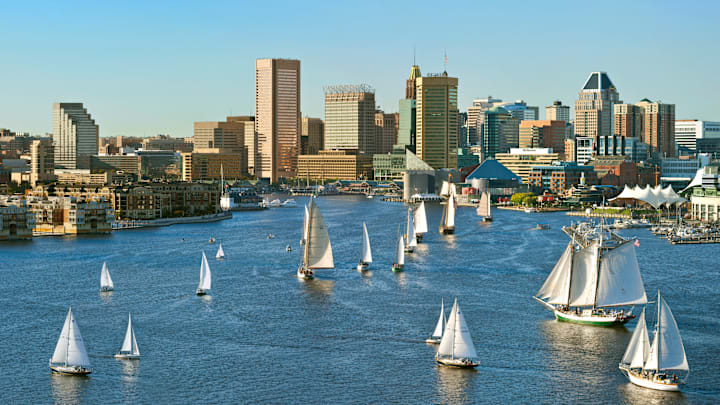Washington, D.C., hasn’t always been the political center of the United States. In fact, nine different cities across the country have served as the nation’s capital at one point or another, even if only for a day (and technically, some of them can’t be called capitals of the United States, but the capital of the colonies).
- Philadelphia, Pennsylvania
- Baltimore, Maryland
- Lancaster, Pennsylvania
- York, Pennsylvania
- Princeton, New Jersey
- Annapolis, Maryland
- Trenton, New Jersey
- New York, New York
- Washington, D.C.
Philadelphia, Pennsylvania

The First Continental Congress had to meet in Carpenters’ Hall from September 5 to October 26, 1774, because Independence Hall was being used by the Pennsylvania General Assembly. Philly has been home to Congress sessions on six separate occasions, making it the most frequent U.S. capital (although not the longest-used one).
Baltimore, Maryland

Baltimore, Maryland, was briefly the capital when the Continental Congress decided it would be best to get out of Philadelphia since the British were coming. They thought Baltimore might be a good temporary home, but they were wrong: one delegate rudely called the town “an extravagant hole.” They returned to Philly as soon as possible—but didn’t stay for long. By September, the situation was taking a turn for the worse again.
Lancaster, Pennsylvania

This city has the distinction of being capital for merely a day. On September 27, 1777, the Continental Congress was forced to flee Philadelphia because the British had forced them out during the American Revolution. They met there for just a single day before moving even farther away from the redcoats.
York, Pennsylvania

York is actually where the Articles of Confederation were drafted. York sometimes declares itself the “First Capital of the United States” because the Articles of Confederation are the first known legal documents to actually refer to the colonies as “the United States of America.” The Declaration of Independence uses the phrase as well, but some historians say it wasn’t a legal document at the time because the colonies were still under British rule.
Princeton, New Jersey

Nassau Hall hosted the Congress of the Confederation from July through October 1783. Princeton University says that while Congress was here, they “congratulated George Washington on his termination of the war, received news of the signing of the definitive treaty of peace with Great Britain, and welcomed the first foreign minister—from the Netherlands—accredited to the United States.” The reason why Congress adjourned to Princeton is pretty interesting: they were mobbed at Independence Hall by a bunch of soldiers demanding payment for the Revolutionary War. Instead of paying them, Congress elected to move from town to town for the next few years.
Annapolis, Maryland

The Maryland State House in Annapolis served a similar function from November 26, 1783 to August 13, 1784, and a couple of historic events took place here: George Washington resigned as commander in chief of the Continental Army, and the Articles of Confederation were ratified (although the latter was actually done a couple of years prior to Congress occupying the State House).
Trenton, New Jersey

The Congress of the Confederation held their meetings here at the French Arms Tavern. But don’t think that our early politicians were just slacking off and enjoying a pint or two—the building really was the most suitable based on its size. One historian called it “The handsomest and most commodious house in Trenton in its day.”
New York, New York

Federal Hall in New York City was home to Congress for a total of about four years. It’s where Washington had his inauguration as the first president of the United States. In fact, when the first United States Congress met there in 1789, the first thing they did was tally the votes that would declare Washington commander in chief. In turn, Washington declared that a permanent housing solution for the frequently-traveling lawmakers was in order. You can still see Federal Hall to this day; it’s on Wall Street.
Washington, D.C.

Finally, in 1790, the Residence Act was passed. This gave George Washington the freedom to pick a place for the permanent capital and allowed him to give builders 10 years to complete the job. He chose D.C. for its spot on the Potomac River and to somewhat appease James Madison and Thomas Jefferson, who wanted a more southern location for the capital than New York, which is where they had been meeting for several years prior.
Discover More Early United States History:
A version of this story originally ran in 2009; it has been updated for 2025.
